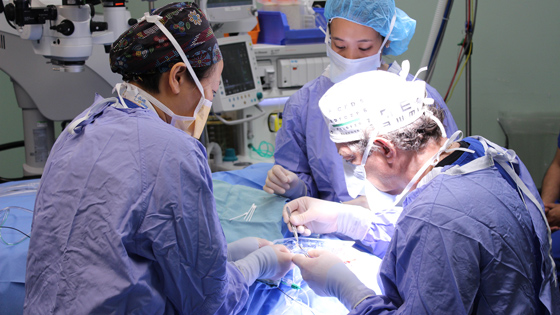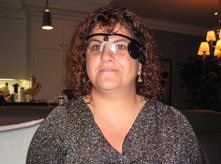
Dr. Robert Devenyi (right) and his surgical team are the first in Canada to successfully implant a retinal prosthesis that will restore a form of vision to blind patients. In this photo, he delicately implants the the internal portion of the device around the patient’s eye (Photo: UHN)
Orly Shamir, 46, had become accustomed to living in the dark.
The credit analyst for a bank in Toronto was born with Leber Congenital Amaurosis (LCA), an eye disorder that primarily affects the retina – the specialized tissue at the back of the eye that detects light and colour.
Although people with LCA and similar types of degenerative eye diseases adapt to the condition and live full lives, the diagnosis can leave patients with a sense of powerlessness as their eye sight deteriorates year after year.
"I used to be able to see objects and read large print when I was a child," said Shamir. "But now, my vision is not at all trustworthy and I've learned to rely on other senses."
There are no existing treatments to stop the progress of the disease which often renders a person essentially blind.
But the Krembil Neuroscience Centre's (KNC) Donald K. Johnson Eye Centre is the first and only centre in Canada to offer a revolutionary procedure that restores functional vision to individuals with some degenerative eye diseases related to Advanced Retinitis Pigmentosa (ARP).
Stimulating the eye to 'see'

Orly Shamir is the first patient in Canada to receive the Argus II device which she is wearing in this picture. Already, the system has allowed her to detect white and black colours. (Photo: UHN)
In June 2014, Shamir was the first patient in Canada to receive the Argus Retinal Prosthesis System (Argus II), a device that stimulates the eye with electrodes to transmit visual information captured by a video camera to the patient's brain.
In a healthy eye, the photoreceptors in the retina convert light into tiny electrochemical pulses that are sent through the optic nerve and into the brain, where they are decoded into images. If the photoreceptors no longer function correctly due to conditions such as LCA, the first step in this process is disrupted and the visual system cannot transform light into images.
The Argus II bypasses the damaged photoreceptors through several electrodes implanted on the surface of the retina. Patients wear glasses containing a miniature camera that convert captured video images into a series of small electrical pulses that are transmitted wirelessly to the electrodes. The pulses stimulate the retina's remaining cells which transmit the visual information along the optic nerve to the brain.
The vision provided is not the same as regular sight, but allows the patient to perceive patterns of light, observe if doors and windows are open, step up on a curb or pick up a glass.
"This is one of the most exciting medical developments I have witnessed in my career," said Dr. Robert Devenyi, Ophthalmologist-in-Chief and Director, Retinal Services at UHN who performed Shamir's surgery. "Although this device is relatively new, it offers so much hope and possibility for patients with degenerative eye disease. I am delighted to be part of the first team in Canada that can provide this technology to patients."
After the device is implanted, patients work with rehabilitation experts, low vision therapists and consultants from Second Sight, the California-based developers of the Argus II, to learn how to use the device and interpret the visual information they are now receiving.
From dark to light
For Shamir, a married mother of three boys, the device has already had an impact. Although she didn't let her limited sight interfere with her activities such as cycling and dragon boat racing, having a form of vision restored has been both an exciting and emotional experience.
Shamir received the device as part of an observational study to collect additional information about its safety and how it affects subjects' vision. Following surgery, she worked with rehabilitation specialists to learn how to use the Argus II system, and interpret the visual information captured by the device.
"It has only been three months since my surgery, but there is already a difference in what I can perceive visually," she said. "It can truly be described as going back to childhood and starting all over to learn to see but, I can now detect contrast and recognize the difference between white and black colours."
Since the device provides a form of artificial vision, re-training the brain to learn and understand the input and messages it receives from the device is an important part of the post-surgery rehabilitation.
Patients also learn to use their new vision by connecting physical information with visual information. For example, touch is initially used to identify the shape of a three-dimensional object. Patients will touch the object as well as look at the object while using the Argus II but, over time, they are able to recognize different shapes without touching them.
"Retraining of skills is an on-going process after patients receive the implant," said Dr. Samuel Markowitz, a low-vision rehabilitation specialist at Toronto Western Hospital working with the study participants. "These skills will build over time allowing patients to become more independent and improve their quality of life."
Shamir will continue with follow-up visits for the next nine months. Some appointments will take place in her home under the direction of low vison therapists, including Dr. Michelle Markowitz, an optometrist working with study participants, who will help her maximize the use of the device.
"Progress takes time and I'm committed to continue to work with the specialists and increase my improvements," said Shamir. "I'm so grateful for this opportunity and excited for what it will allow me and others with similar conditions to do in the future."
Related Links
